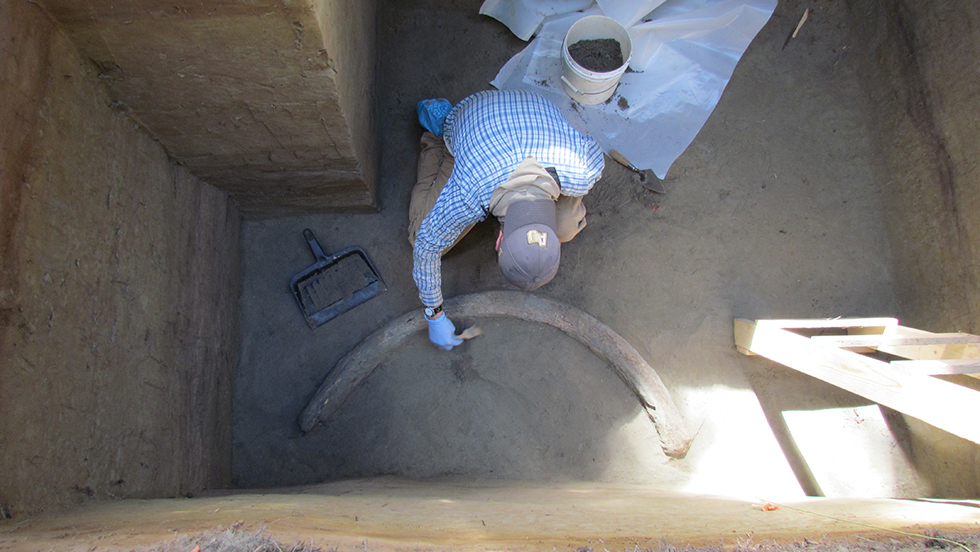
A study involving Adelphi anthropology faculty members has helped tell the life story of a female woolly mammoth who died 14,000 years ago. Their research is shedding light on the intertwined lives of humans and mammoths as the mammoths became extinct after the last Ice Age.
Anthropologists like Associate Professor Kathryn Krasinksi, PhD, and Professor Brian Wygal, PhD, director of environmental studies and sciences, who regularly visit the Holzman archaeological site in Alaska, have long speculated on the roles of climate changes or human interaction on the extinction of the woolly mammoths that roamed the Alaskan wilderness for hundreds of thousands of years before becoming extinct after the last Ice Age.
Both Dr. Krasinski and Dr. Wygal were among the expert co-authors of the uniquely collaborative multiyear, multi-expert and multi-institutional research study, “A female woolly mammoth’s lifetime movements end in an ancient Alaskan hunter-gatherer camp,” published in the January issue of Science Advances.
Recently, by tracing and analyzing the sources of isotopes found in the tusk of Elma, a female woolly mammoth unearthed at Swan Point, Alaska, by the University of Alaska Fairbanks research team—a hunter-gatherer encampment and the oldest archaeological site in the state—anthropologists gained new insights into her life and possible causes of her extinction.
Tracking a Life in a Tusk
Strontium, an element in the plants Elma ate, left behind a measurable trace each day on her six-foot-long tusk. The more strontium in the soil where she grazed, the greater its presence on her tusk.
For this study, co-author Matthew Wooller, PhD, director of the stable isotope facility at the University of Alaska Fairbanks, which is home to more than a thousand mammoth remains, took the lead on the isotopic analysis of Elma’s tusk, using a protocol followed with the tusk of Kik, a 17,000-year-old male. Noting that the tip of Kik’s tusk had strontium levels matching the site where he died, researchers were able to work backward to determine his travels during his lifetime.
Dr. Krasinski’s contributions to the Science Advances study included investigation, providing resources from the Holzman site, and writing, review and editing, while Dr. Wygal’s contribution also included investigation, editing and provided resources. “It was a great experience to also meet with the artist who designed the journal’s cover and consult on the ethics of portraying people as well as details of what the area would have looked like 14,000 years ago,” Dr. Krasinski said.
In 2016, the two colleagues were part of a team of students and fellow anthropologists who discovered a virtually complete 14,000-year-old woolly mammoth tusk at the Holzman site. For nine years, the professors have conducted collaborative archaeological research at Holzman, often training Adelphi and other students in fieldwork at the important site.
“What we contributed to the Science Advances article, in a nutshell, is a DNA and radiocarbon sample from the tusk recovered at Holzman,” Dr. Krasinski recalled. “My focus was presenting and explaining the evidence found at the Holzman site in relation to how humans interacted with animals that have a trunk-like nose, such as mammoths, and comparing the evidence from Holzman to that of nearby Swan Point to understand similarities or differences in human-animal interactions between the two locations.”
According to Dr. Krasinski, this study replicated, sequenced and compared DNA from the Holzman tusk with that of other mammoths—including Elma—in a large mammoth database. “This was so cool. It was the first time we had integrated results from this part of Alaska, which established a clear ancestor-descendant relationship between Holzman and Swan Point. And there was significant genetic variation to indicate there were likely distinct herds living in Shaw Creek at the time.”
The Adelphi colleagues were involved in this project for several years. “These types of projects take significant time to make sure data and people are in place,” remarked Dr. Krasinski, who, like Dr. Wygal, will again be traveling to the Holzman site during this summer’s thaw.
Reconstructing Relationships
Dr. Krasinski considers that the relationships between the people who lived at these sites and the mammoths at the end of the Ice Age were integral to the fate of the mammoths. “People knew about mammoths, and mammoths probably knew about people as well. People and animals sometimes developed and shared each other’s trails.” She also noted that tusks were meaningful to the early hunter-gatherers, who, at Holzman, even fashioned tools from mammoth ivory.
After the Ice Age, as grasslands shrunk, mammoth habitat diminished and humans were more likely to share an environment with the mammoths. Perhaps then, as evidence from the analyses of mammoth tusks suggests, it was a combination of climate change impact on grazing lands and human interactions that hastened the extinction of the mammoths.